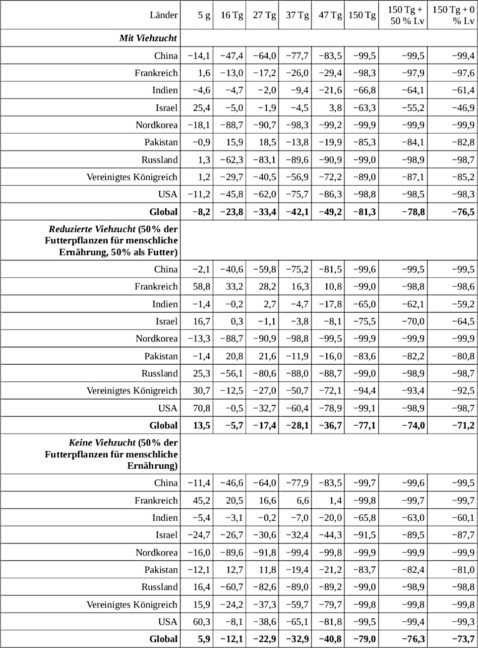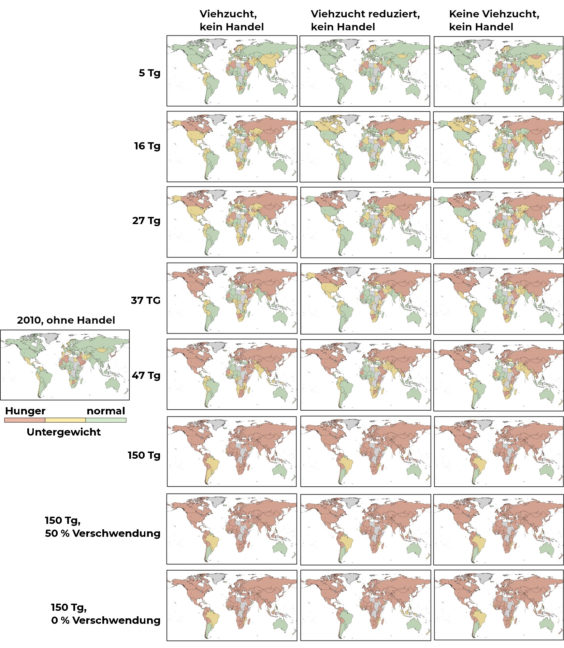By Martin Auer
How would the climate impact of a nuclear war affect global nutrition? A research team led by Lili Xia and Alan Robock from Rutgers University investigated this question. the Study was just published in the journal nature food published.
The smoke and soot from burning cities would literally darken the skies, massively cool the climate, and severely hamper food production. The model calculations show that up to two billion people could die as a result of food shortages in a “limited” war (e.g. between India and Pakistan), and up to five billion in a “major” war between the USA and Russia.
The researchers used climate, crop growth and fisheries models to calculate how many calories would be available to people in each country in the second year after the war. Various scenarios were examined. A “limited” nuclear war between India and Pakistan, for example, could inject between 5 and 47 Tg (1 teragram = 1 megaton) of soot into the stratosphere. That would result in a 1,5°C to 8°C drop in average global temperature in the second year after the war. However, the authors point out, once nuclear war has begun, it may be difficult to contain it. A war between the US and its allies and Russia - which together hold more than 90 percent of the nuclear arsenal - could produce 150 Tg of soot and a temperature drop of 14,8°C. During the last Ice Age 20.000 years ago, temperatures were around 5°C lower than today. The climatic effects of such a war would recede slowly, lasting up to ten years. The cooling would also reduce precipitation in regions with summer monsoons.
Table 1: Atomic bombs on urban centers, explosive power, direct fatalities due to bomb explosion and number of people at risk of starvation in the scenarios examined
Table 1: The 5 Tg soot contamination case corresponds to an assumed war between India and Pakistan in 2008, in which each side uses 50 Hiroshima-sized bombs from their then available arsenal.
The cases of 16 to 47 Tg correspond to a hypothetical war between India and Pakistan with the nuclear armament they may have by 2025.
The case with 150 Tg contamination corresponds to an assumed war with attacks on France, Germany, Japan, Great Britain, the USA, Russia and China.
The numbers in the last column tell how many people would starve if the rest of the population were fed the minimum of 1911 kcal per person. The assumption assumes that international trade has collapsed.
a) The figure in the last row/column is obtained when 50% of feed production is converted to human food.
The local radioactive contamination of soil and water in the vicinity of the bomb explosions is excluded from the study, the estimates are therefore very conservative and the actual number of victims would be higher. The sudden, massive cooling of the climate and the reduced incidence of light for photosynthesis (“nuclear winter”) would lead to delayed ripening and additional cold stress in food plants. At mid and high latitudes, agricultural productivity would suffer more than in subtropical and tropical areas. Stratospheric pollution with 27 Tg of black carbon would reduce harvests by more than 50% and fishery yields by 20 to 30% at mid- and high-latitudes in the northern hemisphere. For the nuclear-armed countries China, Russia, USA, North Korea and Great Britain, the calorie supply would decrease by 30 to 86%, in the more southerly nuclear states Pakistan, India and Israel by 10%. Overall, in the unlikely scenario of a limited nuclear war, a quarter of humanity would starve to death due to the effects of climate change; in a larger war, the more likely scenario, over 60% of people would starve to death within two years.
The study, it must be emphasized, only refers to the indirect effects on food production of the soot development of a nuclear war. However, belligerent states still have other problems to contend with, namely destroyed infrastructure, radioactive contamination and disrupted supply chains.
Table 2: Change in the availability of food calories in the nuclear-armed countries
Table 2: China here includes Mainland China, Hong Kong and Macao.
Lv = food waste in households
However, the consequences for nutrition depend not only on the climate change caused. The model calculations combine various assumptions about the number of weapons used and the resulting soot with other factors: Does international trade continue, so that a local food shortage can be compensated for? Will the production of animal feed be replaced in whole or in part by the production of human food? Is it possible to completely or partially avoid food waste?
In the "best" case of contamination with 5 Tg of soot, global harvests would fall by 7%. In that case, the population of most countries would need fewer calories but would still have enough to sustain their labor force. With greater contamination, most middle- and high-latitude countries would starve if they continued to grow animal feed. If feed production is halved, some mid-latitude countries could still provide enough calories for their populations. However, these are average values and the question of distribution depends on the social structure of a country and the existing infrastructure.
With an "average" contamination of 47 Tg soot, enough food calories for the world population could only be guaranteed if feed production was switched to 100% food production, there was no food waste and the available food was distributed fairly among the world population. Without international compensation, less than 60% of the world's population could be adequately fed. In the worst case studied, 150 Tg of soot in the stratosphere, world food production would fall by 90% and in most countries only 25% of the population would survive in the year two after the war.
Particularly strong harvest declines are predicted for important food exporters such as Russia and the USA. These countries could react with export restrictions, which would have catastrophic consequences for import-dependent countries in Africa and the Middle East, for example.
In 2020, depending on estimates, between 720 and 811 million people suffered from malnutrition, although more than enough food was produced globally. This makes it likely that even in the event of a nuclear disaster, there would be no equitable distribution of food, either within or between countries. The inequalities result from climatic and economic differences. Great Britain would have a stronger harvest decline than India, for example. France, currently a food exporter, would have a food surplus in the lower scenarios due to disruption to international trade. Australia would benefit from a cooler climate that would be better suited to growing wheat.
Figure 1: Food intake in kcal per person per day in year 2 after soot contamination from nuclear war
Figure 1: The map on the left shows the food situation in 2010.
The left column shows the case with continued livestock feeding, the middle column shows the case with 50% of forage for human consumption and 50% for forage, the right shows the case without livestock with 50% of forage for human consumption.
All maps are based on the assumption that there is no international trade but that food is distributed evenly within a country.
In regions marked in green, people can get enough food to continue their physical activities as usual. In regions marked in yellow, people would lose weight and could only do sedentary work. Red means calorie intake is less than basal metabolic rate, leading to death after depletion of fat stores and expendable muscle mass.
150 Tg, 50% waste means that 50% of the food otherwise wasted in the household is available for nutrition, 150 Tg, 0% waste means that all the otherwise wasted food is available for nutrition.
Graphic from : Global food insecurity and famine from reduced crop, marine fishery and livestock production due to climate disruption from nuclear war soot injection, CC BY SA, translation MA
Alternatives in food production such as cold-resistant varieties, mushrooms, seaweed, proteins from protozoa or insects and the like were not considered in the study. It would be an overwhelming challenge to manage the switch to such food sources in a timely manner. The study also only refers to dietary calories. But humans also need proteins and micronutrients. So much remains open for further studies.
Finally, the authors emphasize once again that the consequences of a nuclear war - even a limited one - would be catastrophic for global food security. Two to five billion people could die outside the theater of war. These results are further evidence that nuclear war cannot be won and must never be waged.
Cover photo: 5ofnovember via deviantART
Spotted: Verena Winiwarter
This post was created by the Option Community. Join in and post your message!






